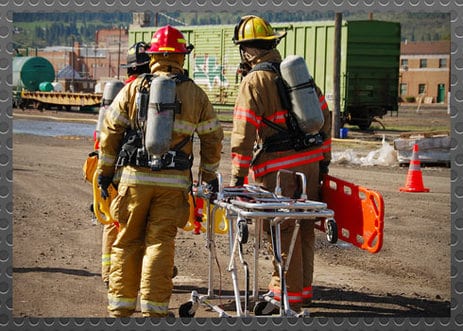- About Us
- Our Services
- Training Expertise
- Crisis Management for Business & Industry
- DOT PHMSA ALERT Rail Car Training
- Emergency Management
- Environmental & HAZMAT
- First Response & HAZWOPER
- Maritime Security
- OSHA Training/Confined Space
- RDPC
- Safer News Gathering
- Safer Ohio Schools Using Threat Assessment Management
- School Safety & Security
- Workplace Violence Prevention
- Courses
- Our Clients
- Media
Handling HAZMAT Incidents As A Firefighter Would

An EHS manager or technician is often no stranger to HAZMAT incidents. Numerous industries handle harmful substances as part of their daily routine, and experienced EHS professionals are expected to have response plans in place, with phases that range from evacuation and containment to remediation and recovery, as the case may demand.
First responders, especially firefighters, are not responsible for hazardous materials in the same way as manufacturing and transportation safety managers. A fire service usually deals with HAZMAT only when an incident escalates to an emergency level. Of course, firefighters train far more often than most corporate production or transportation staff. That training takes hazardous materials releases into account, providing those responders with a confident response plan up to the point where they call for a dedicated HAZMAT team.
Today, first responders encounter hazardous substances more frequently than was once the case.
There are many dubious circumstances that involve noxious chemicals, ranging from drug labs to suicide attempts. Glendale, California fire captain Phil Ambrose recently contributed a fine article to fireengineering.com, where he detailed a few calls that were not identified as including dangerous chemicals or gases before his team reached the site. On arrival, however, it became clear that lethal substances were present in large quantity, and that immediate action was needed to save lives. As a result, firefighters were initially working without HAZMAT team support and were forced to take actions that would otherwise have been left to the specialists.
Ambrose lists five factors that first responders are wise to remember when they encounter victims in a toxic environment, specifically one that is gas-filled. We think these points are also useful for EHS professionals who are notified of a HAZMAT release at their facility.
- Ventilation: Ambrose points out that enclosed areas increase toxic concentrations. So, to reduce the concentration of toxins, immediately ventilate the area as the first order of business.
- Respiratory Protection: Before entering the affected area, take the appropriate steps to protect yourself from the gases that may have filled a space after a chemical spill. Most likely, this means donning an SCBA. Never enter a toxically contaminated space without proper respiratory equipment, no matter how urgent the need.
- Exposure Protection: Hazardous chemicals and their resulting fumes can be lethal skin dangers as well as harmful (even deadly) inhalants. Protective garments for firefighters are called ‘turnouts’, and the Ambrose article suggests that, in order to save a life, the typical garb is most often sufficient for “a quick grab” of a victim, even though turnouts “do not provide chemical-contact protection.” But the day-to-day work clothing worn by most people is not protective garb by any means. So, donning PPE is also a must before entry into a toxic environment.
- Decontamination: A water decon is the most common means of clearing a toxic substance from the skin of a victim. Water is one thing firefighters typically have in abundance, and so a decontaminating flush is usually a quick and easy step for them. In-house response teams may not have a water source as close at hand. Safety showers may be well-placed, but it’s nearly impossible to put one anywhere it could be needed. EHS managers should consider how they might get a lot of water to an exposure victim quickly, at least enough to douse the victim before they are rushed to a safety shower. And, a victim will likely have contaminated clothing that needs to be stripped away at once. Be sure to stock disposable coveralls or robes that can be worn by victims immediately after they have dispensed with their clothing.
- Plans and Assessments: EHS managers for facilities with toxic hazards are charged with the responsibility of planning for HAZMAT releases and training employees about how to react. But what about after the spill is contained and any victims are treated? As Ambrose says, firefighters are “very good at doing postmortem analysis—dissecting what went right and what went wrong—of every fire they run.” Fire teams strive to improve their results on every call, and consistent and quick analysis of the previous call is one key way to do that. EHS managers should not overlook the value of reviewing how any HAZMAT incident was handled, no matter how small. The incident review will tell you how you might improve facilities to better react to the next spill – or to prevent it entirely.
Findlay All Hazards is a national leader in HAZMAT control training. We teach thousands every year how to better prep their workspaces and how to more effectively respond to any kind of unanticipated incident. Contact us to learn how we can build a custom training program for your company.
